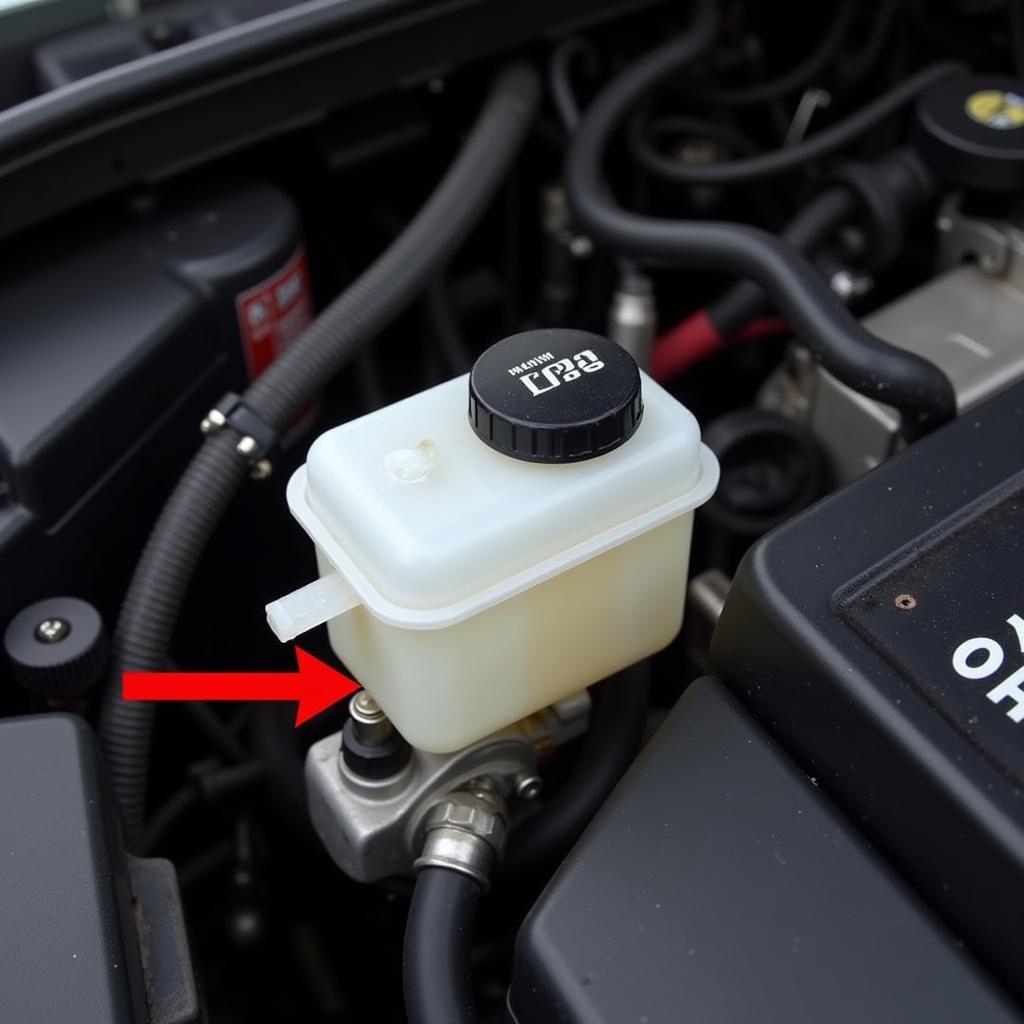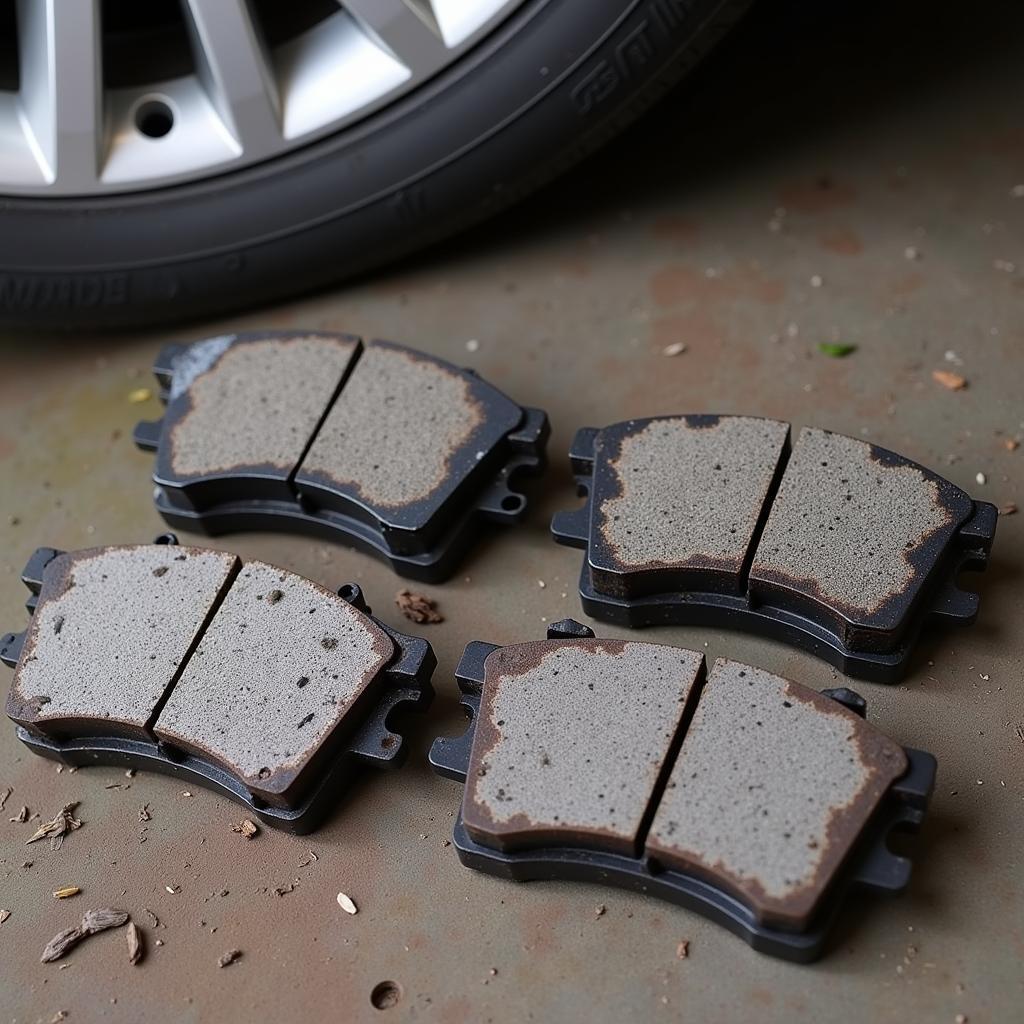The brake system warning light on your Mazda dashboard is a crucial safety indicator that should never be ignored. This light typically illuminates as a red exclamation mark within a circle or parentheses, often accompanied by the word “BRAKE.” When this light comes on, it signifies an issue with your Mazda’s braking system that requires immediate attention.
While a flashing light usually indicates a critical problem, a steady light could suggest a less severe but still important issue. This article will guide you through the potential reasons behind the brake system warning light in your Mazda and provide steps on how to address them.
Common Causes of a Brake System Warning Light in Mazda Vehicles
There are several reasons why your Mazda’s brake system warning light might be activated. Let’s explore some of the most common culprits:
1. Low Brake Fluid Level
One of the most frequent reasons for the brake system warning light is a low brake fluid level. Brake fluid is essential for transmitting the force applied to the brake pedal to the brake calipers, ultimately stopping your vehicle.
What causes low brake fluid?
- Brake pad wear: As your brake pads wear down, the brake calipers need to extend further to engage the rotors. This extension requires more brake fluid, eventually leading to a lower fluid level in the reservoir.
- Brake fluid leak: A leak in the brake lines, hoses, or calipers can result in a significant loss of brake fluid, triggering the warning light.
 Mazda Brake Fluid Reservoir
Mazda Brake Fluid Reservoir
2. Engaged Parking Brake
It might seem obvious, but a common oversight is driving with the parking brake partially or fully engaged. Even a slightly engaged parking brake can trigger the warning light. Always ensure the parking brake is fully released before driving.
3. Faulty Brake Light Switch
The brake light switch is a small component responsible for activating your brake lights when you press the brake pedal. A malfunctioning brake light switch can disrupt the brake system’s electrical circuit, leading to the warning light illumination.
4. ABS System Malfunction
Modern Mazdas are equipped with an Anti-lock Braking System (ABS), designed to prevent wheel lockup during hard braking. A problem within the ABS system, such as a faulty wheel speed sensor or ABS control module, can trigger the brake system warning light.
 Mazda ABS Wheel Speed Sensor
Mazda ABS Wheel Speed Sensor
5. Master Cylinder Issues
The master cylinder acts as the heart of your Mazda’s braking system, converting the force from the brake pedal into hydraulic pressure. A failing master cylinder can lead to a loss of brake pressure and activate the warning light.
“A malfunctioning master cylinder can be extremely dangerous,” warns John Miller, a seasoned automotive engineer with over 20 years of experience working on Mazda vehicles. “If you suspect an issue with your master cylinder, it’s critical to have it inspected by a qualified mechanic immediately.”
What to Do When Your Mazda’s Brake System Warning Light Comes On
If the brake system warning light illuminates while driving, it’s crucial to take immediate action to ensure your safety:
- Safely pull over: As soon as it’s safe, activate your hazard lights and pull over to the side of the road. Avoid sudden braking if possible.
- Check the parking brake: Ensure the parking brake is fully disengaged.
- Check brake fluid level: With the engine off, carefully open the hood and locate the brake fluid reservoir. Check the fluid level against the minimum and maximum markings on the reservoir.
- Add brake fluid (if necessary): If the brake fluid level is low, carefully add the correct type of brake fluid recommended for your Mazda model. Refer to your owner’s manual for specific instructions.
- Assess brake pedal feel: With the engine running, carefully press the brake pedal. Does it feel spongy, unusually hard, or go all the way to the floor?
- Contact a qualified mechanic: If the brake fluid level is significantly low, you notice a leak, or the brake pedal feels abnormal, do not attempt to drive further. Contact a qualified mechanic specializing in Mazda vehicles to diagnose and repair the issue.
Preventing Brake System Issues in Your Mazda
Regular maintenance is key to preventing brake system problems and ensuring the longevity of your Mazda:
- Regular brake inspections: Adhere to the recommended brake inspection intervals outlined in your Mazda’s owner’s manual.
- Timely brake pad replacement: Replace your brake pads before they wear down completely, as this can damage the rotors and lead to more costly repairs.
- Brake fluid flushes: It’s recommended to flush your Mazda’s brake fluid every 2-3 years or as recommended by your mechanic. This helps maintain optimal brake system performance and prevents corrosion.
 Mazda Brake Pad Replacement
Mazda Brake Pad Replacement
“Preventive maintenance is far more cost-effective than addressing major brake system repairs down the line,” advises Sarah Jenkins, a certified automotive technician with extensive experience servicing Mazda vehicles. “By following your Mazda’s recommended maintenance schedule, you can significantly reduce the risk of unexpected brake problems.”
Conclusion
The brake system warning light in your Mazda is a crucial safety indicator that should never be disregarded. Understanding the potential causes and knowing how to react when the light comes on can help you stay safe on the road.
Remember, regular maintenance is essential for preventing brake system issues and ensuring the optimal performance and longevity of your Mazda. If you encounter any problems or have concerns about your Mazda’s braking system, always consult a qualified mechanic specializing in Mazda vehicles for a thorough inspection and professional repair.


